“As an art-hungry child growing up on the wrong side of the world, I shall be forever grateful to a man called Albert Felton who, when he succumbed to prostate cancer in Melbourne in 1904, left his entire fortune to be managed as a bequest fund. Half the income was to go to public charities, and the other half to the Melbourne picture gallery, later the National Gallery of Victoria.
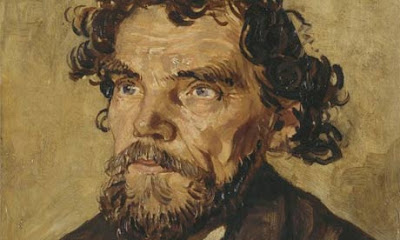
Someone did this painting… but who?
“The gallery staff have bought wisely with the billion dollars or so that the bequest has brought. I can still remember the first time when, as a small girl, I tiptoed towards a small panel of the Mother and Child limned in jewel colours, set in a dimly lit room of its own, as if upon an altar. It was acquired in 1923 as by Jan van Eyck; it is now reattributed to the Flemish school, on no better grounds than that the Madonna doesn’t sit upon a throne, as she does in other Van Eycks, but upon a cushion. A Monk With a Book in the style of Titian is actually a Titian. A self-portrait by Rembrandt isn’t, but the portrait of Doge Pietro Loredano, thought to be a copy of a Tintoretto, turns out to be the original, after which all the other versions of this famous portrait have been made. Few provincial galleries have had the chance to play for such high stakes, and it is to the credit of the gallery’s directors that they have so often found themselves on the winning side…”
Germaine Greer: Not a Van Gogh, but is it a Rubens? Guardian Unlimited.
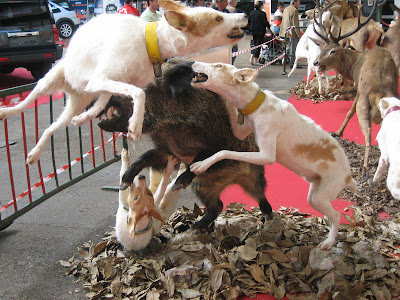
“It used to be that good-looking waiters and cold plonk were the sole essentials of a good museum opening. Maybe there were some crackers on a tray. These days, though, no such fete is complete without a little curbside controversy, some wacko bit of theater, a harried staff of professional-event duennas and a guest list that can often seem as if it were composed by shredding the White Pages and picking names out of a hat.
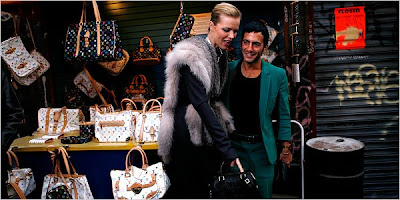
Eva Herzigova and Marc Jacobs at the Brooklyn Museum
“Here, then, at the gala opening of the Takashi Murakami retrospective at the Brooklyn Museum on Thursday, an evening of unseasonal chill and spitting rain, was the obligatory chorus of protesters on Eastern Parkway, raising voices against the developer Bruce C. Ratner, who was being honored that night for his support of the arts at the annual Brooklyn Ball.
To those on one side of the museum’s new glass-walled addition, Mr. Ratner is a deep-pocketed patron and, as the museum’s director, Arnold Lehman, said, “a nice boychick from Cleveland, Ohio.” To those at curbside on Eastern Parkway, he was viewed less benignly, as Satan. Most developers are.
“Atlantic Yards is truly going to make a lot of people miserable,” said one protester, Eleanor Price, referring to Mr. Ratner’s $4 billion plan to refashion downtown Brooklyn into a commercial wonderland of shops, a basketball arena and fanciful buildings by Frank Gehry. “They’re using eminent domain to get rid of a lot of people and to close businesses,” Ms. Price said. “Where are they going to go?”
This Is Not a Sidewalk Bag, The New York Times.
“Next month in New York, for the first time ever, Christie’s is including a house in a sale of post-war and contemporary art. Along with some multi-million-dollar Rothkos and Warhols will be the Kaufmann House, a minimalist 3,200-square foot residential house in the Californian desert designed in 1946 by one of the leading modernist architects of the day, Richard Neutra.
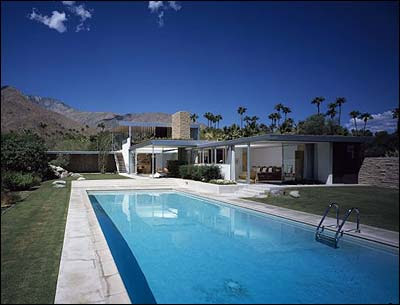
The Kaufmann House is a minimalist 3,200-square foot residential house in the Californian desert.
“In doing this, Christie’s is marketing architecture as art and expecting the buyer to pay the premium – in this case between $15 million (£7.3 million) and $25 million (£12.4 million).
“Andrea Fiuczynski, Christie’s president in Los Angeles, says they are including it in an art sale because, “not only is it a timeless masterpiece, and the last important example of modernist architecture in the Americas to remain in private hands, but it is also symptomatic of the trend to include design in contemporary art sales. The barriers between the two disciplines have now become blurred…'”
Art sales: is it a house, or a work of art?, The Telegraph UK.
“David Hockney has given the largest painting he has ever made – a landscape 12 metres long by five metres tall (40ft by 15ft) – to the Tate.
“The work, Bigger Trees Near Warter (2007), is a monumental-scale view of a coppice in Hockney’s native Yorkshire, between Bridlington and York. It was painted on 50 individual canvases, mostly working in situ, over five weeks last winter.
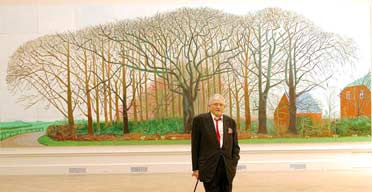
Old bloke and painting.
“Although Hockney settled in Los Angeles in 1978, he has always spent Christmas at his mother’s house in Bridlington. Four years ago, he began to work there seriously, splitting his time between Yorkshire and California, with the rolling chalk hills around Bridlington the focus of his art…”
Hockney donates huge work to Tate, The Guardian.
